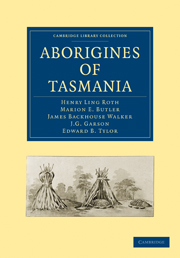Book contents
- Frontmatter
- PREFACE
- Contents
- ILLUSTRATIONS
- CHAP. I INTRODUCTION
- CHAP. II FORM AND SIZE
- CHAP. III PSYCHOLOGY
- CHAP. IV WAR
- CHAP. V FIRE
- CHAP. VI NOMADIC LIFE
- CHAP. VII METHOD OF WEARING HAIR
- CHAP. VIII ASTRONOMY
- CHAP. IX STRING
- CHAP. X TRADE
- CHAP. XI INFANTICIDE
- CHAP. XII LANGUAGE
- CHAP. XIII OSTEOLOGY
- CHAP. XIV ORIGIN
- APPENDICES
- INDEX
- Plate section
CHAP. IX - STRING
Published online by Cambridge University Press: 05 December 2011
- Frontmatter
- PREFACE
- Contents
- ILLUSTRATIONS
- CHAP. I INTRODUCTION
- CHAP. II FORM AND SIZE
- CHAP. III PSYCHOLOGY
- CHAP. IV WAR
- CHAP. V FIRE
- CHAP. VI NOMADIC LIFE
- CHAP. VII METHOD OF WEARING HAIR
- CHAP. VIII ASTRONOMY
- CHAP. IX STRING
- CHAP. X TRADE
- CHAP. XI INFANTICIDE
- CHAP. XII LANGUAGE
- CHAP. XIII OSTEOLOGY
- CHAP. XIV ORIGIN
- APPENDICES
- INDEX
- Plate section
Summary
“THE natives made use of a grass rope, which was passed round their body and the tree [for climbing]. To make such a rope some eight or ten men would all begin in a most expert way to pull the long wiry grass; and when they had sufficient would all run together, and mix it; then half of them would get small crooked sticks and twist the grass, whilst the others let it out into small fine ropes. Then all these ropes were twisted together into one strong one.… One custom of the aborigines was to plait strings from the bark of a yellowcoloured shrub, equal to flax, both in strength and fineness, and found in abundance” (J. Scott, Papers etc., Roy. Soc, Tasm., July, 1873). In describing the natives' method of catching the opossum, Lloyd mentions, that they used “a strong wire-grass rope, made into close threestrand plait” (p. 46). Backhouse also speaks of this rope, and says one of kangaroo skin was used previous to the use of European hemp”(p. 172). It will be .remembered that the rafts described by Péron, La Billardiere (II. ch. xi. p. 80), and Backhouse (p. 58), were fixed up with grass cord. “They always carried with them a small rope, made of kangaroo sinews” (Davies, p. 413). Some “had a slender cord bound several times round the head.
- Type
- Chapter
- Information
- Aborigines of Tasmania , pp. 143 - 152Publisher: Cambridge University PressPrint publication year: 2009First published in: 1890

